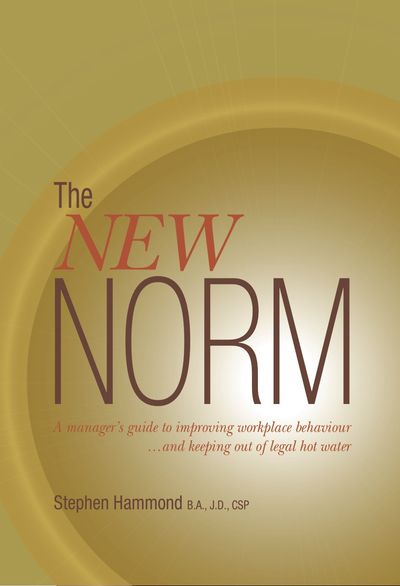Chapter twenty one
THE NEW NORM is proactive, heading off complaints before they happen
After two weeks of training, Jennifer Steeves started work at Woody’s Place, one of several bars near Moncton, New Brunswick owned by Brian Dalling under the company name RPK Inc. Steeves’ immediate supervisor was Jeff Johnson, who made inappropriate comments that even Johnson later agreed were inappropriate.
He observed aloud that Steeves' breasts were shrinking since she started an exercise regime; he asked her if she had any tattoos or piercing in hidden places; he commented on the colour of her underwear; and he suggested that he could arrange to put her together with a male friend if she ever broke up with her boyfriend.
After two and a half years of this, Steeves decided that an inappropriate touch from Johnson during a meeting was the last straw. (He claimed that the touch was just to let her know he had arrived.) She gave her letter of resignation to the owner, Dalling.
Although it was Dalling’s first notification of problems, he immediately suspended Johnson with pay while investigating the matter. And two days later, he told Steeves that he wanted her to stay with the company and would ensure limited or no contact between her and Johnson if Johnson returned.
She declined the offer, didn’t go back to work at Woody’s and filed a complaint of sexual harassment with the New Brunswick Human Rights Commission. Meanwhile, Johnson never returned to work and was fired a few weeks later.
Here’s a case where the owner’s response was textbook-perfect; Dalling clearly believed what Steeves said, but had to balance the rights of Johnson, a supervisor, and Steeves, an employee. That’s why, instead of firing Johnson right away, he suspended him pending an investigation. And in order to keep Steeves, he assured her she wouldn’t have to work with Johnson if/when he returned. What more could he have done?
According to Canadian human rights legislation and jurisprudence, management is ultimately responsible for what goes on at work. The New Brunswick Human Rights Board of Inquiry chairperson wrote, “Based upon the findings of fact, the Board concludes that on a balance of probabilities, Ms. Steeves was the subject of sexual harassment and therefore discrimination as a result of the actions of her supervisor Mr. Johnson…
…The Board therefore concludes that Mr. Johnson is in violation of the Act. Furthermore, the employer RPK has violated these same sections of the Act…The Commission has established to the satisfaction of the Board that the behaviour of Mr. Johnson was unwelcome to Ms. Steeves and also of a sexual nature.”
It's clear that Mr. Dalling could have greatly benefited from taking my Respectful Workplace online course, where we spell out that even though he did a good job after the fact, he could have prevented sexual harassment at work if he’d been pro-active.
As a result, the chairperson awarded Steeves financial compensation. However, human rights law is also meant to be remedial, not punitive. While finding the company liable, the chairperson wanted to reflect the remedial nature of the owner’s actions. This case isn’t that old (2007), yet even by human rights standards, the award of $2,000 granted to Steeves is quite small.
Steeves asked for twelve weeks’ compensation in lieu of notice because she felt she was forced out. Being awarded some notice pay is very common in similar cases. However, in this case the chairperson felt Steeves should have accepted the offer of staying on with limited or no contact with her former harassing boss.
“Ms. Steeves was not fully satisfied with this proposal and decided to leave her employment. In the view of the Board, although the decision of Ms. Steeves may have been right for her, there is very little else the employer could be expected to do to address this matter. Accordingly, the Board is of the view that this is not an appropriate case to order the remedy requested.”
The Board found the actions of Brian Dalling to be “commendable.” It confirmed that he was responsible by law, and did the right thing by responding quickly and responsibly. But the lesson is that it cost his company dearly anyway (in losing and having to replace two employees, as well as the time and energy involved in defending the complaint), pointing to the value of taking the initiative to educate and remind employees of these issues in hopes of proactively preventing problems.
The OLD NORM
- may be a good employer, but merely responds to harassment and discrimination instead of preventing it proactively.
- leaves supervisors to figure out what is right and wrong, instead of giving them sufficient training – after all, they should know better.
- expects employees to stand up to supervisors, even if they have concerns about their job.
- is surprised to find himself liable when he thinks he has done everything correctly.
The NEW NORM
- is proactive, letting all employees know about sexual harassment and other forms of discrimination before an incident happens.
- gives training to all employees, and extra training to supervisors to ensure everyone knows what is expected.
- lets all employees know they can come to the “big boss” or someone senior if they need to address sexual harassment.
- continues to balance the rights of all employees, doing proper due diligence if a complaint comes forward.
Suggestions for the New Norm:
01
An ounce of prevention can save you a lot of headaches. Even in a case like this one, where the financial award is relatively small, the award is typically the smallest cost. Hiring replacement employees and responding to a formal human rights complaint is very time consuming and a serious business cost, never mind the emotional toll.
02
Be proactive. In this case the adjudicator commended Dalling’s proactive response and intervention, but there’s another, better type of proactivity that might have avoided this whole mess: ensuring that every employee and supervisor knew what was acceptable and what was not. The simplest of training might have accomplished this.
03
Give supervisors extra instruction. This can be achieved through formal training, coaching sessions and general meetings. Such training involves more than just sexual harassment – there are many things supervisors need to know about rights and responsibilities at work.
This chapter lets you know the importance of owners and managers preventing sexual harassment at work, allowing them to spend time on the business, and not on legal proceedings.
For an extreme example of management neglecting their duties, leading to a 23 year legal battle, consider reading
Chapter 9: The New Norm won’t make people fight for simple justice.
Purchase a copy of The New Norm, or if you think all your supervisors and managers, could learn many valuable lessons about creating a respectful workplace, free of harassment, bullying and discrimination, you can get volume discounts.
What one reader has to say about Stephen’s book, The New Norm
“Stephen’s book is a brilliant reminder of workplace situations that are disturbing, yet slip by unaddressed by so many in both the private and public sector. When these behaviours are unaddressed, they become the norm because we allow them to be.
Just like his first book, Stephen is insightful, his writing is moving and he inspires his readers to take immediate action to disapprove of, and address harassment and other inappropriate behaviour every time we see it, feel it and hear about it. In a concise format, he gives us a series of snapshots of old vs. new, acceptable vs. unacceptable, right vs. wrong, in a way that is understandable.
If workplace leaders take just some of Stephen’s practical advice, they will go a long way to rid their workplace of unacceptable behaviours such as harassment, discrimination and bullying. It’s clear that to create Stephen’s “New Norm,” we need to ACT NOW! We can’t wait any longer.”
Tatjana Zatezalo
Manager, Organizational Development, Halifax Regional Municipality

Respectful Workplace Online Training Course
If you, your employees or your managers want more information,
sign up for my new online training course:
The Respectful Workplace in Canada.
With 10 modules of useful, relevant and current information,
this course can help everyone at your workplace.
This may be the best online harassment training your people will get.
Stephen Hammond is a lawyer turned speaker and consultant in the field of harassment, sexual harassment, bullying and discrimination at work.
The New Norm is Stephen’s third book.
Here’s more information about Stephen.




